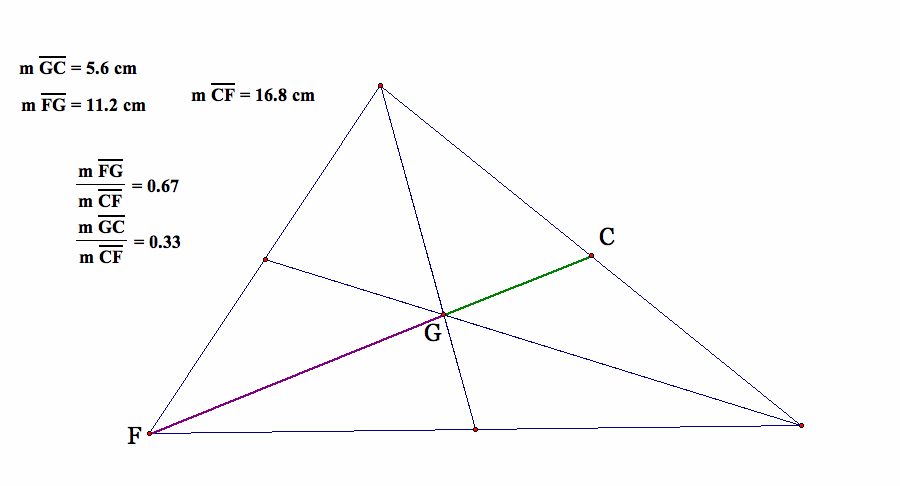

Assignment 4
for
Amanda Newton
The centroid (G) of a triangle is the common intersection of the three medians. A median of a triangle is the segment from a vertex to the midpoint of the opposite side. Use Geometer's Sketchpad (GSP) to construct the centroid and explore its location for verious shapes of triangles.
Click here for a centroid tool for GSP.
Arguably, the most common of centroid explorations and proofs is the 1:2 ratio of the segments made by the intersections of the medians. This may be easier to see but holds for the centroid of any triangle (the ratio will stay the same despite the area or dimensions). The figure below shows the relationship of one of these segments. This relationship hold from all three median segments. We can also see that the smallest segment GC is 1/3 of the median FC while FG is 2/3 of FC. (This makes more sense of the 1:2 ratio because 2/3=2(1/3)).

To prove the above relationship of 1:3 ratio we can use the medial triangle to help us along. The medial triangle shown below is the triangle made by connecting the three midpoints of the sides of the original triangle. The medial triangle seperates the original into 4 congruent triangles (this holds for any triangle as shown below).



Let's prove the above conjecture to ensure maximum understanding of the relationships:

But let's talk more specifically about centroids. The point of concurrency of the 3 medians of a triangle is 2/3 of the distance of each median. The proof is as follows:

Take the midpoint of the segment AG, BG, and GC. The segment JH is parallel to segment BC and JH=1/2BC by the mid-segment theorem. Similarly, ED is parallel to BC and ED=1/2BC by the mid-segment theorem. If JH and ED are both parallel to BC then JH and ED are parallel. Likewise, if JH=1/2BC and ED=1/2BC, then JH is congruent to ED. Therefore, by the properties of parallelograms, the quadrilateral EDJH must be a parallelogram. Another property of parallelograms is that the diagonals bisect each other. So JG=GD and EG=GH. The intersection appears to be the centroid of the original triangle. Let's construct another quadrilateral IJDF (shown below).

Using the same proof that the quadrilateral EDJH is a parallelogram, similar steps follow that IJDF is also a parallelogram and its diagonals bisect each other at the same point G, which is also the centroid of the triangle ABC. Following from the theorem that the diagonals of a parallelogram bisect each other then IG=GF, but we also know that IG=AI from our original construction. So AI=IG=GF and AI+IG+GF=AF, therefore AI=IG=GF=1/3AF. It follows then that AG=2/3AF. Using the same argument, BG=2/3BD and GC=2/3EC.